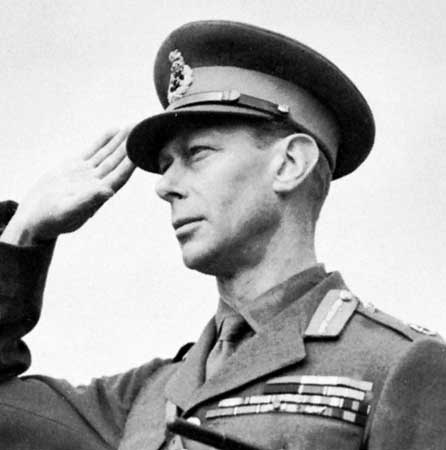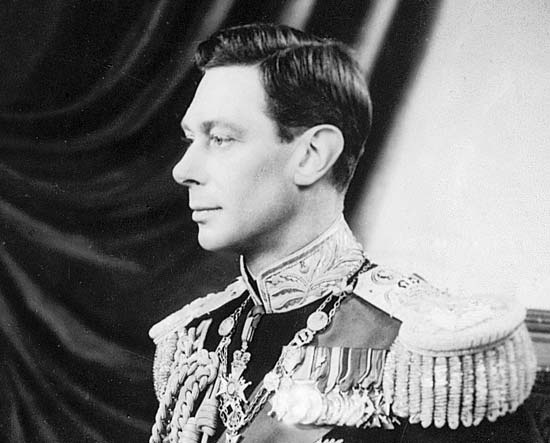George VI
king of United Kingdom
also called (1920–36) Prince Albert, duke of York, in full Albert Frederick Arthur George
born Dec. 14, 1895, Sandringham, Norfolk, Eng.
died Feb. 6, 1952, Sandringham
 king of the United Kingdom from 1936 to 1952.
king of the United Kingdom from 1936 to 1952.The second son of the future king George V, the prince served in the Royal Navy (1913–17), the Royal Naval Air Service (1917–19), and the Royal Air Force (1919) and then attended Trinity College, Cambridge (1919–20). On June 3, 1920, he was created duke of York. He sponsored the annual Duke of York's Camp (1921–39), at which equal numbers of public (private) school boys and boys from industrial areas spent a week together as his guests. On April 26, 1923, he married Lady Elizabeth Angela Marguerite Bowes-Lyon (Elizabeth), youngest daughter of the 14th earl of Strathmore and Kinghorne. They had two children: Princess Elizabeth (afterward Queen Elizabeth II) and Princess Margaret (later countess of Snowdon).
 The duke of York assumed the throne on Dec. 11, 1936, following the abdication of his brother Edward VIII; he was officially proclaimed king the following day. He took the name of George VI and was crowned on May 12, 1937. Before the outbreak of World War II, the king affirmed Anglo-French solidarity and formed a close friendship with U.S. President Franklin D. Roosevelt, but he supported Prime Minister Neville Chamberlain's “appeasement” policy toward Germany and Italy. In May 1940, when the House of Commons forced Chamberlain to resign, the king wished to appoint Edward Halifax (later 1st earl of Halifax) to the premiership but was induced to select Winston Churchill, whose wartime leadership he then supported unreservedly. During the war he visited his armies on several battle fronts.
The duke of York assumed the throne on Dec. 11, 1936, following the abdication of his brother Edward VIII; he was officially proclaimed king the following day. He took the name of George VI and was crowned on May 12, 1937. Before the outbreak of World War II, the king affirmed Anglo-French solidarity and formed a close friendship with U.S. President Franklin D. Roosevelt, but he supported Prime Minister Neville Chamberlain's “appeasement” policy toward Germany and Italy. In May 1940, when the House of Commons forced Chamberlain to resign, the king wished to appoint Edward Halifax (later 1st earl of Halifax) to the premiership but was induced to select Winston Churchill, whose wartime leadership he then supported unreservedly. During the war he visited his armies on several battle fronts.Although King George had ceased to be emperor of India when India and Pakistan became separate independent countries, he was formally recognized, on April 27, 1949, as head of the Commonwealth of Nations by the governments of its member states. From 1948 on, the king's health deteriorated, and he died a few months after undergoing an operation for lung cancer.
Although he was an important symbolic leader of the British people during World War II, his reign was perhaps most important for the accelerating evolution of the British Empire into the Commonwealth of Nations and the postwar transformation of Great Britain into a welfare state. He earned respect by scrupulously observing the responsibilities and limitations of a constitutional monarch and by overcoming the handicap of a severe stammer.
Additional Reading
Denis Judd, King George VI, 1895–1952 (1982); and Patrick Howarth, George VI (1987), study his private life and political influence.
- Sir Keith Macpherson; and Smith Smith, Sir Ross Macpherson
- Sir Keith Sinclair
- Sir Kenelm Digby
- Sir Kenneth MacMillan
- Sir Kingsley Amis
- Sir Lawrence Alma-Tadema
- Sir Lawrence Bragg
- Sir Leander Starr, Baronet Jameson
- Sir Leander Starr Jameson, Baronet
- Sir Lennox Berkeley
- Sir Leonard Hutton
- Sir Leonard Woolley
- Sir Leslie Stephen
- Sir Leslie Ward
- Sir Lewis Bernstein Namier
- Sir Louis-Hippolyte, Baronet LaFontaine
- Sir Louis-Hippolyte LaFontaine, Baronet
- Sir Lynden Oscar Pindling
- Sir Macfarlane Burnet
- Sir Mackenzie Bowell
- Sir Malcolm Bradbury
- Sir Malcolm Campbell
- Sir Malcolm Sargent
- Sir Marc Isambard Brunel
- Sir Mark, 6th Baronet Sykes